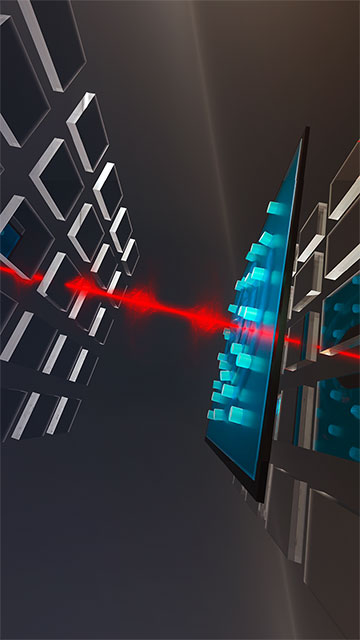Researchers have demonstrated how laser light can interact quantum-mechanically with an oscillating membrane loaded with nanopillars (blue in this artist's impression), which is sandwiched between two periodically patterned mirrors. The apparatus operates at room temperature. [Image: EPFL & Second Bay Studios]
Observing and exploiting quantum effects in macroscopic objects is hampered by the extreme sensitivity of those effects to thermal fluctuations, meaning that such measurements are usually carried out at close to absolute zero.
A group in Switzerland has now shown that it is possible to measure the quantum-mechanical phenomenon of squeezing using a solid-state mechanical resonator in an optical cavity that operates at room temperature (Nature, doi: 10.1038/s41586-023-06997-3). The researchers did so by employing phononic engineering to sharply reduce the noise of both the cavity and the resonator.
Squeezing demonstrations
Heisenberg's uncertainty principle tells us that nature imposes a minimum combined uncertainty on specific pairings of observable parameters, such as a particle's position and momentum. Squeezing involves trading off the uncertainty of one parameter against that of the other, allowing measurements to be made below the usual quantum shot-noise limit. This possibility is exploited, for example, in gravitational-wave detectors, where the error in either the phase or amplitude of the detector's laser signals can be minimized according to the wave frequency of interest (see “Squeezing the Best Out of Gravitational Waves,” OPN, May 2020).
Researchers have also demonstrated squeezing in much smaller "optomechanical" devices. The idea is to expose a mechanical oscillator to laser light and observe the effect that vacuum fluctuations in the light's amplitude have on the object's vibrations―via the change in phase of the output light. This process creates a correlation between the light's amplitude and phase, which increases the overall uncertainty in the system. However, although squeezing cannot be achieved via amplitude and phase noise directly, it can instead be detected by comparing noise levels in different linear combinations of the two variables.
Some optomechanical demonstrations have relied on cryogenic cooling, while others have involved levitation. Some in this latter category have provided evidence of squeezing by recording vacuum fluctuations in the position of a nanometer-sized sphere illuminated and held in position by a suitable laser beam. In another case, researchers used an optical cavity at room temperature―employing levitation to isolate a minuscule mirror from its environment. But this system lost coherence before it could complete even one oscillation period.
Minimizing noise
In the latest work, Tobias Kippenberg and colleagues at the Swiss Federal Institute of Technology Lausanne (EPFL) say they have shown how to demonstrate the same physical effects with a solid-state resonator. They used what is known as a membrane-in-the-middle (MIM) system, consisting of an oscillating membrane sandwiched between a pair of mirrors that together form a Fabry–Pérot cavity. They exposed the system to infrared laser light and measured the output by interfering it with the original beam in a single-port homodyne detector.
To make their setup sensitive to quantum effects at room temperature, the researchers minimized a number of different noise sources. Among these was that of the cavity mirrors, which they patterned with a precision circular saw in order to create a grid-like phononic structure that screened out vibrations within a certain frequency band (about 0.9–1.2 MHz)―reducing noise in this region by more than a factor of 700. At the same time, they were able to make a resonator with an exceptionally high quality factor―180 million―by studding a very thin piece of silicon nitride with amorphous silicon nanopillars to isolate a high-quality oscillating mode (at 1.16 MHz).
The researchers observed squeezing by varying the phase difference between the light leaving the cavity and the reference beam arriving directly from the laser. They used that phase difference to set up two mutually orthogonal linear combinations of the light's phase and amplitude, such that the noise in one combination was reduced below the level of shot noise while that in the other rose above it.
For each phase setting, they recorded the noise of the cavity output using a spectrum analyzer. Repeating the process across 32 different phase angles, they were able to establish which combinations of phase difference and frequency yielded the biggest reductions compared with shot noise. Or, as group member Nils Engelsen (now at Chalmers University of Technology in Sweden) puts it, how "quantum" each measurement was. (The resonator completed about 30 oscillations before losing coherence.)
Toward lower vibrational states
They found they were able to reduce the intensity of laser noise below that of shot noise by as much as 22 percent, or about 1.1 dB.
They found they were able to reduce the intensity of laser noise below that of shot noise by as much as 22 percent, or about 1.1 dB. They point out that this indicates that they are still a factor of 2.5 above the Heisenberg limit on the combined uncertainties in the position of and force experienced by the membrane. Nevertheless, Kippenberg says that the work marks the advent of “room-temperature quantum optomechanics,” which, he adds, has been a decades-old challenge.
The researchers say that just one or two quite feasible improvements to the system―such as raising the mechanical quality factor and band gap by factors of two or three―should make it possible to reach the lowest possible vibrational state. They point out that there is ongoing research to use this type of system in magnetic resonance force microscopy, with the aim of imaging single atoms within complex molecules such as proteins.


